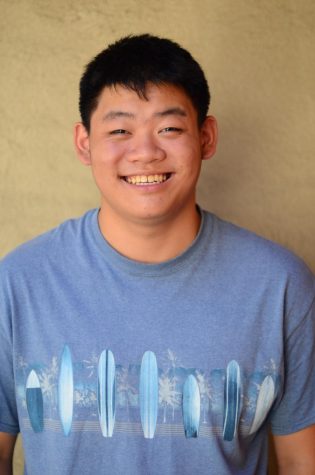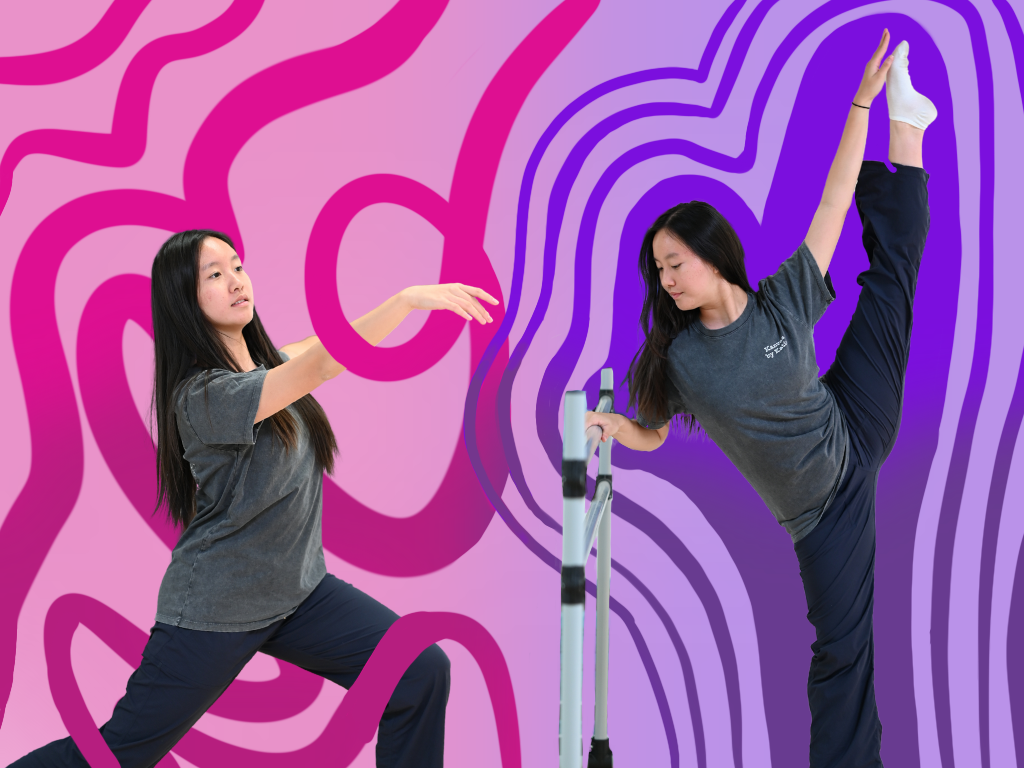Equity Beat: Puerto Rico a month after Hurricane Maria
Courtesy of Mariana Janer
A basketball court is shown littered with trees after Hurricane Maria hit Puerto Rico. After a month following the hurricane, the area still remains in devastating conditions.
October 23, 2017
Destructive gusts of wind of up to 155 miles per hour flooded houses and frightened Puerto Ricans: this was the scene during the category four Hurricane Maria that hit Puerto Rico over three weeks ago as described by Mariana Janer, a high school sophomore living in suburban San Juan.
Widespread flooding and power outages occurred as a result of the hurricane, leaving millions of Puerto Ricans without access to both water and electricity. Despite power being restored in the capital of San Juan for the most part, electricity is still extremely limited in Puerto Rico, with rural villages having little to no access to cellular service and the overwhelming majority of the island having no power.
The Federal Emergency Management Agency (FEMA), has been working to rebuild Puerto Rico’s infrastructure in addition to distributing goods such as food, water and gas, but a FEMA spokeswoman revealed in a statement to Harker Aquila that the agency is running low on funds after disasters in both Texas and Florida.
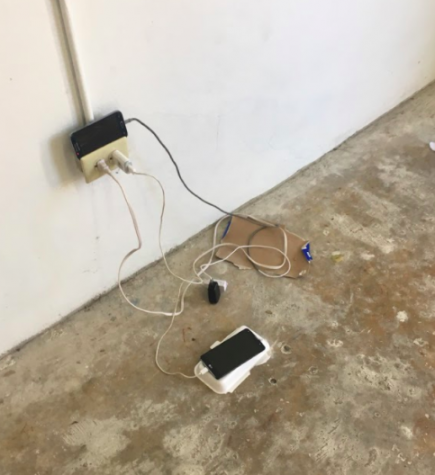
A phone charges through a broken-down outlet in the wall. Puerto Ricans are still struggling to obtain electricity a month after the hurricane.
Along with continued electrical problems in the capital, Mariana described prices for food and water surging after the hurricane.
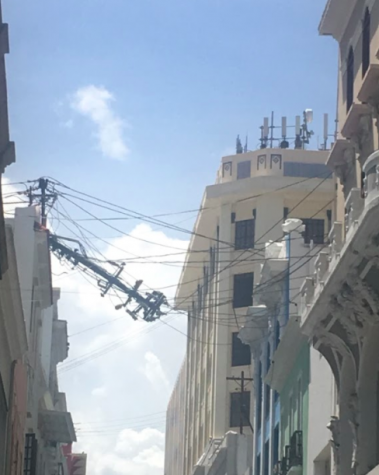
Overhead power lines are held up by two adjacent buildings. Puerto Ricans are still struggling to obtain electricity a month after the hurricane.
“There was not any bread or milk in the first week after the hurricane, and water prices were skyrocketing,” Mariana said. “There’s still problems with the electricity here in San Juan and we’re the ones that are the best off on the whole island.”
Andrew Chang (11), co-president of the upper school United Nations International Children’s Emergency Fund (UNICEF) club, believes that non-profit groups are doing a good job at helping Puerto Ricans recover from the hurricane.
“I think many organizations such as the Red Cross and UNICEF are truly working hard despite being under difficult situations to alleviate the damage done to Puerto Rico,” Andrew said. “Overall, Puerto Rico definitely needs more help, but these organizations have done a lot I think in helping those in need.”
The Trump administration faced criticism in the days following the hurricane concerning federal relief efforts. The mayor of San Juan, Carmen Yulin Cruz, took to Twitter to voice the gravity of what she termed Puerto Rico’s “life or death” situation.
In response, President Trump alleged that Democrats persuaded Cruz to point out the president’s shortcomings. Others, such as the governor of Puerto Rico, Ricardo Rossello, pointed out the government is not sending enough supplies to Puerto Rico after the hurricane.
“The Mayor of San Juan, who was very complimentary only a few days ago, has now been told by the Democrats that you must be nasty to Trump,” Trump said in a tweet.
International relations and economics teacher Damon Halback believes that the U.S. government has not given Puerto Ricans the same relief funding as the government did after Harvey in Texas or Irma in Florida.
“The U.S. government has yet to authorize the same quantities of money that were authorized for similar disasters in the United States and give Puerto Rico’s infrastructure problems,” Halback said. “The hurricane’s impact hit Puerto Rico more acutely than Miami or Houston, and therefore has been somewhat underfunded during its recovery.”
A week after Hurricane Maria struck Puerto Rico, President Trump temporarily waived the century-old Jones Act which prohibited foreign ships from delivering goods to the island. Mariana points out the slow relief efforts after the hurricane struck which she says is due in part because of the Jones Act.
“The responses have been horrible since we have not been getting what we need, compared to how fast aid was delivered in Texas and Miami, because of things like the Jones Act,” Mariana said. “A U.S. navy hospital ship arrived here in San Juan only a few days ago which is weeks after the actual hurricane hit.”
Hurricane Maria originated in the tropical Atlantic several hundreds East of the Caribbean. It quickly picked up power and rose to a category five hurricane. By the time the hurricane reached Puerto Rico, however, the hurricane had decreased in power to a category four storm, yet still, parts of Puerto Rico experienced 30 inches of rain in a single day.
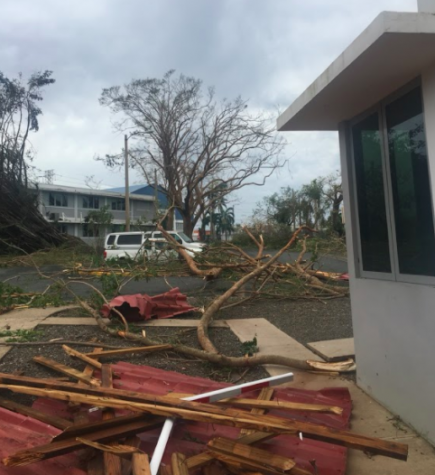
Remnants of a fallen tree and a house lay next to a building. Puerto Ricans are still struggling to obtain electricity a month after the hurricane.
Before hitting mainland Puerto Rico, Hurricane Maria, a then-category five hurricane with top sustained winds of 175 miles per hour, hit the small island nation of Dominica, which is home to nearly 74,000 people and the French region of Guadeloupe, which is home to half a million. The hurricane killed at least one person in Guadeloupe and was the first category five hurricane to ever hit Dominica with the last hurricane experience there being a category four in 1979.
After Hurricane Maria’s devastating path through the Caribbean and eventually to Puerto Rico, at least 48 people have been killed, at least 10 of whom were Puerto Rican.
There are numerous ways to help those affected by the hurricane in Puerto Rico, such as donating to a variety of GoFundMe campaigns and organizations such as the Puerto Rican Relief Fund, United for Puerto Rico, One America Appeal and All Hands Volunteers.


















![“[Building nerf blasters] became this outlet of creativity for me that hasn't been matched by anything else. The process [of] making a build complete to your desire is such a painstakingly difficult process, but I've had to learn from [the skills needed from] soldering to proper painting. There's so many different options for everything, if you think about it, it exists. The best part is [that] if it doesn't exist, you can build it yourself," Ishaan Parate said.](https://harkeraquila.com/wp-content/uploads/2022/08/DSC_8149-900x604.jpg)




![“When I came into high school, I was ready to be a follower. But DECA was a game changer for me. It helped me overcome my fear of public speaking, and it's played such a major role in who I've become today. To be able to successfully lead a chapter of 150 students, an officer team and be one of the upperclassmen I once really admired is something I'm [really] proud of,” Anvitha Tummala ('21) said.](https://harkeraquila.com/wp-content/uploads/2021/07/Screen-Shot-2021-07-25-at-9.50.05-AM-900x594.png)







![“I think getting up in the morning and having a sense of purpose [is exciting]. I think without a certain amount of drive, life is kind of obsolete and mundane, and I think having that every single day is what makes each day unique and kind of makes life exciting,” Neymika Jain (12) said.](https://harkeraquila.com/wp-content/uploads/2017/06/Screen-Shot-2017-06-03-at-4.54.16-PM.png)








![“My slogan is ‘slow feet, don’t eat, and I’m hungry.’ You need to run fast to get where you are–you aren't going to get those championships if you aren't fast,” Angel Cervantes (12) said. “I want to do well in school on my tests and in track and win championships for my team. I live by that, [and] I can do that anywhere: in the classroom or on the field.”](https://harkeraquila.com/wp-content/uploads/2018/06/DSC5146-900x601.jpg)
![“[Volleyball has] taught me how to fall correctly, and another thing it taught is that you don’t have to be the best at something to be good at it. If you just hit the ball in a smart way, then it still scores points and you’re good at it. You could be a background player and still make a much bigger impact on the team than you would think,” Anya Gert (’20) said.](https://harkeraquila.com/wp-content/uploads/2020/06/AnnaGert_JinTuan_HoHPhotoEdited-600x900.jpeg)

![“I'm not nearly there yet, but [my confidence has] definitely been getting better since I was pretty shy and timid coming into Harker my freshman year. I know that there's a lot of people that are really confident in what they do, and I really admire them. Everyone's so driven and that has really pushed me to kind of try to find my own place in high school and be more confident,” Alyssa Huang (’20) said.](https://harkeraquila.com/wp-content/uploads/2020/06/AlyssaHuang_EmilyChen_HoHPhoto-900x749.jpeg)




